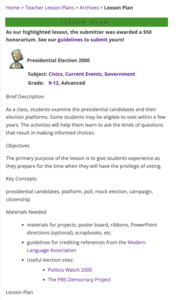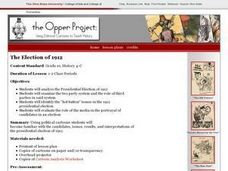Encyclopedia Britannica
Beyond a Two-Party System
Young political scientists go beyond the two-party system and research third-party candidates running in the 2020 US Presidential election. Groups present background information about the candidate, the party's platform points, and a...
Curated OER
Presidential Election Year: Major Issues
Whether or not it's a presidential election year, this debate activity will spark research on current political issues. Split your government scholars into 4 groups and assign each a political party. One person will be the "candidate"...
Curated OER
Presidential Election 2000
Students examine the presidential candidates and their election platforms. They further analyze the platforms by creating a chart to determine which candidate most represents his or her beliefs and values.
Curated OER
Cartoons for the Classroom: Fair Elections?
Rigged elections make for both intriguing current events and hilarious political cartoons. In this analysis worksheet, pupils read background information to help them grasp a cartoon about rigged presidential elections in 2007 by Russia,...
Curated OER
Mock Election
Here is an excellent PowerPoint presenting loads of information about the US election process. Some of the topics included in the slide show: the reasons voting is important, how to choose a candidate, how the federal, state, and local...
Brown University
The Candidates and Their Values: Election 2016
Voting for the next president of the United States is about finding the candidate who most closely aligns with your own values and sense of democracy. High schoolers become acquainted with the candidates from the 2016 election with a...
Teaching Tolerance
Why Local Elections Matter
Uncle Sam wants everyone to vote in local elections! Geared toward middle and high school scholars, the resource explores voter turnout and the importance of local elections. Academics participate in group discussion, complete...
John F. Kennedy Presidential Library & Museum
Red States/Blue States: Mapping the Presidential Election
Young historians investigate how voting patterns have changed by comparing the outcome of the 1960 election to the outcome of the recent election. A creative final assessment has participants making a news show wherein they provide...
Constitutional Rights Foundation
The Election of 1912
The Election of 1912: an election with four competitive opponents. Pupils get to know the candidates with informative reading passages that provide context to the election. Then, the class engages in a debate and answers questions as one...
Curated OER
The Election of 1912
Tenth graders examine the Election of 1912. In groups, they identify the roles of the Democratic and Republican parties along with any third party mentioned. Using the internet, they describe the main issues of this election and discuss...
Constitutional Rights Foundation
Winner-Take-All: The Two-Party System
Two's company, three's a crowd. High school historians learn about the Electoral College, a two-party, winner-take-all voting system in the United States. The lesson explains the pros and cons of the two-party system, roadblocks for...
Constitutional Rights Foundation
The Troubled Elections of 1796 and 1800
Congress does more than create new laws. Political scientists delve into the elections of 1796 and 1800 to understand how political parties, the Electoral College, and personal agendas affected the election process. The resource also...
Curated OER
Islamists Prepare for Egypt's Election
Wether your class posts a blog response or simply answers these questions, they'll end up more informed about Egyptian politics and conflict. They read the attached article and then answer seven comprehension questions regarding Hosni...
Curated OER
Presidential Elections: A Simulation
Feeling ambitious about getting your scholars examining the election process? While this presidential election simulation will take preparation, the ensuing enthusiasm will be worth it! Using one or more large classes, 12th graders are...
Carolina K-12
Exploring the Electoral College
Does your vote really count? This activity helps young voters learn about the electoral college through a TED talk, a helpful handout, discussion prompts, and then a role-playing activity that has participants simulating an election on a...
Carolina K-12
Are You a Democrat or a Republican? Are You Really?
Have new or soon-to-be voters examine different political parties and their platforms as they figure out which one aligns most with their beliefs. After taking a few online quizzes, students split into pairs to discuss and then in larger...
Constitutional Rights Foundation
Elections, Money, and the First Amendment
Those who spend the most, win. Academics read informational text, participate in group discussion, and defend campaign reforms to understand the correlation between money, the First Amendment, and election results. The resource explains...
Curated OER
The Two-Party System: Chapter 5
Guide your students' reading with this worksheet. Included are five matching and five multiple choice questions focused on aspects of the two-party system employed in the United States. Use as a quiz, guided reading questions, or homework.
Curated OER
Development of American Political Parties: The Two-Party System
Was American politics always bound to the two-party system? Learn how the two-party system developed, why third parties tend not to do so well, and all the various political parties that have emerged throughout US history. Each party is...
Curated OER
Introductions to Elections and Government
Eighth graders explore the process of election. In this elections and government instructional activity, 8th graders complete a K-W-L chart and research the Internet to complete a fact sheet and report on to their peers. This...
Curated OER
Representation: Elections
Students study and examine how elections are conducted in Australia. In this representation lesson plan, students make comparisons regarding systems of voting. Students explore the three levels of government and discuss federal...
Curated OER
The Two-Party System in American History: Ch 5
Five matching and 5 multiple choice questions to challenge your class. Their answers will test their knowledge of early American government. Party systems, Electorate, and major constituents of the time are the topics included.
Curated OER
Hold Your Own Ice Cream Election!
Use ice cream to represent Presidential candidates in this mock election.
City University of New York
Electoral College
A presidential election is a lot like the 2004 World Series, and it's also a lot like choosing an orange in a paper bag. Apply the process of the electoral college to these two analogies with a set of lessons about government...

























